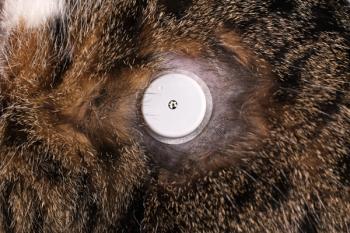
Research Update: Are we overdiagnosing hypothyroidism in sighthounds?
The prevalence of hypothyroidism in dogs ranges from 0.2% to 0.8%.1 Although thyroxine (T4) assays are widely available, the variability in serum T4 concentrations in healthy and sick dogs means that, unfortunately, no single, specific diagnostic test exists for hypothyroidism. In addition to abnormal concentrations of one or more thyroid axis hormones, a hypothyroidism diagnosis also requires the presence of consistent clinical signs that resolve with appropriate therapy. However, although low T4 concentrations are the most commonly noted hormone abnormality in dogs with hypothyroidism, any concurrent illness may result in euthyroid sick syndrome, which refers to decreased circulating T4 and triiodothyronine (T3) concentrations despite a normally functioning thyroid gland.2 In addition, breed variability in normal serum T4 concentrations exists, with greyhounds known to have serum T4 concentrations less than that of the general dog population.3
(IMAGENAVI/GETTY IMAGES)
Despite these two well-documented conditions—euthyroid sick syndrome and lower serum T4 concentrations in greyhounds—hypothyroidism is oftentimes diagnosed inappropriately in dogs with concurrent diseases or in greyhounds in general despite a lack of consistent clinical signs. The authors of this study sought to characterize the thyroid axis test results that are being used to diagnose hypothyroidism in sighthounds (the ancestral breed group to which greyhounds belong) and determine whether the lower T4 concentrations noted in greyhounds are also found in healthy Salukis, another sighthound breed.
The retrospective arm of this study reviewed submissions to the endocrinology department of the Diagnostic Center for Population and Animal Health at Michigan State University for serum thyroid hormone measurement over a period of 4.5 years. Cases were included if the dog was a sighthound and test results were subsequently interpreted by the requesting veterinarian as being consistent with hypothyroidism, thereby justifying levothyroxine supplementation. After excluding dogs that were receiving exogenous thyroid hormone supplementation at the time of testing, 398 dogs were included.
Of these dogs, hypothyroidism was diagnosed in 30 (7.5%) despite all thyroid hormone concentrations falling within the reference range, and 286 dogs (71.9%) had either T4 or T3 concentrations below the general dog population reference range, but the thyroid-stimulating hormone (TSH) concentration was either within the reference range (and, therefore, most consistent with euthyroid sick syndrome) or had not been measured. Only 65 dogs (16.3%) had a decreased serum T4 or T3 concentration and either had an increased TSH concentration or thyroglobulin autoantibodies, either of which are more specific for a diagnosis of hypothyroidism when present in conjunction with a decreased serum T4 or T3 concentration.
The prospective cross-sectional portion of this study evaluated five thyroid-associated hormones in 283 healthy Salukis ranging in age from 12 to 167 months and compared these results to the laboratory reference ranges for the general dog population. All Salukis included in this study were determined to be healthy based on owner interviews and the results of physical examinations conducted at the time of blood collection. Dogs were excluded if they were receiving medications that had previously been shown to alter thyroid hormone concentrations, such as corticosteroids and anticonvulsants.
Of these Salukis, 154 of 282 (54.6%) and 120 of 281 (42.7%) had serum T4 or serum T3 concentrations, respectively, below the laboratory reference range. Despite the frequent finding of decreased serum T4 concentrations, only 25 Salukis (8.9%) had concurrent increases in serum TSH concentration, four of which also had thyroglobulin autoantibodies above the upper limit of the laboratory's reference range. Male Salukis had significantly lower T4 and free T4 (fT4) concentrations than females did, and T4, fT4, and TSH concentrations were correlated with both age and body weight.
COMMENTARY
Measurement of serum TSH concentration is recommended to differentiate dogs with euthyroid sick syndrome from those with true hypothyroidism. Most, but not all, hypothyroid dogs have serum TSH concentrations above the reference range, whereas most dogs with euthyroid sick syndrome have normal to decreased TSH concentrations. Despite these well-established test recommendations, this study suggests that hypothyroidism is diagnosed in many sighthounds based on low serum thyroid hormone concentrations alone or despite concurrent inconsistent thyroid function test results. Although the study's authors did not extrapolate their findings to other breeds, anecdotally (including in our experience), this overdiagnosis of hypothyroidism is, unfortunately, not specific to sighthounds.
The authors' finding that hypothyroidism was presumptively diagnosed in 7.5% of sighthounds without abnormal serum thyroid hormone concentrations and thyroid hormone supplementation was administered is concerning. Characteristic clinical signs such as weight gain, decreased activity, and alopecia are an indication for thyroid axis testing; however, these clinical signs are not pathognomonic of hypothyroidism, and an alternative diagnosis should be considered when the serum T4 concentration is within the reference range. If serum T4 concentrations are decreased, the serum TSH concentration should be measured before making a clinical diagnosis. Increased serum TSH concentration, when present in a dog with a decreased T4 concentration, has a sensitivity of 75% and a specificity between 69% and 95% for the diagnosis of hypothyroidism.4 This upregulation of TSH production by the pituitary gland occurs in most hypothyroid dogs when circulating T4 concentrations are inappropriately decreased, but upregulation does not occur in dogs with euthyroid sick syndrome.
One caveat regarding the results reported for the retrospective portion of this study is that the authors assumed that all sighthounds had classic hypothyroidism that could be definitively diagnosed solely based on serum thyroid hormone concentration testing. Unfortunately, an increased serum TSH concentration does not have 100% sensitivity for the diagnosis of hypothyroidism, and some hypothyroid dogs may have TSH concentrations within the reference range. Other supportive evidence in patients in which this disease is highly suspect includes the presence of thyroglobulin autoantibodies, which presumptively correlate with autoimmune thyroiditis. Alternatively, T3 or anti-T4 autoantibodies may cross-react with assays for these particular hormones, and, thus, results within the reference range may not truly reflect serum thyroid hormone concentrations in a given patient. Finally, for unknown reasons, a minority of dogs with clinical signs that suggest decreased thyroid activity persistently have some or all thyroid hormone concentrations within the reference range. After excluding alternative diagnoses, clinical response to empirical levothyroxine supplementation may be considered an acceptable method of indirectly supporting a diagnosis of hypothyroidism in these dogs. The authors did not investigate how many dogs may have had extensive testing to exclude other diagnoses before final repeat thyroid axis testing was attempted, and thyroid hormone supplementation begun. Additionally, it is unclear whether a breed predisposition may exist in these atypical hypothyroid dogs. Perhaps sighthounds are predisposed to having repeatedly normal thyroid function test results despite having thyroid hormone-responsive clinical signs. Despite these theoretical concerns, it would be difficult to accept such a high prevalence of atypical cases as those noted by the authors, and, thus, overdiagnosis of hypothyroidism is the most likely explanation.
The finding that normal Salukis commonly have serum total T4 and fT4 concentrations below those of the general dog population suggests that the previously reported differences in greyhounds may in fact be a sighthound-group finding rather than a breed-specific difference. It is unknown why such a difference would be found in one or more breeds, but the authors reasonably suggest that in some breeds the thyroid hormone receptor could have an increased affinity for T4, T3, or fT4 or, alternatively, that these dogs may have altered (slower) rates of thyroid hormone degradation. In both of these scenarios, a decreased serum T4 concentration would not result in lower intracellular hormone concentrations and would instead be an expected homeostatic finding. Similar studies should be conducted in other sighthound varieties (e.g. Afghan hound, borzoi, Irish wolfhound, Italian greyhound, Scottish deerhound, whippet, and other rarer breeds), before general extrapolation is made. One limitation of this study was that Salukis underwent minimal evaluation, and if a subset of these dogs had undetected hypothyroidism, then the thyroid hormone concentration results would have been biased to be lower than truly expected in healthy members of this breed. Nevertheless, the clinical implication of this breed difference is that a diagnosis of hypothyroidism in Salukis should be based not only on decreased T4, T3, or fT4 concentrations but also on serum TSH concentrations. However, as previously discussed for hypothyroidism in general, because about 9% of healthy Salukis had increased serum TSH concentrations, the clinical diagnosis of hypothyroidism should also depend on the presence of consistent clinical signs.
Source: Shiel RE, Sist M, Nachreiner RF, et al. Assessment of criteria used by veterinary practitioners to diagnose hypothyroidism in sighthounds and investigation of serum thyroid hormone concentrations in healthy Salukis. J Am Vet Med Assoc 2010;236(3):302-308.
The information in "Research Updates" was provided by Scott Owens, DVM, and Barrak Pressler, DVM, PhD, DACVIM, Department of Veterinary Clinical Sciences, School of Veterinary Medicine, Purdue University, West Lafayette, IN 47907.
REFERENCES
1. Scott-Moncrieff JC. Hypothyroidism. In: Ettinger SJ, Feldman EC, eds. Textbook of veterinary internal medicine. 7th ed. St. Louis, Mo: Saunders Elsevier, 2010;1753.
2. Mooney CT, Shiel RE, Dixon RM. Thyroid hormone abnormalities and outcome in dogs with non-thyroidal illness. J Small Anim Pract 2008;49(1):11-16.
3. Shiel RE, Brennan SF, Omodo-Eluk AJ, et al. Thyroid hormone concentrations in young, healthy, pretraining greyhounds. Vet Rec 2007;161(18):616-619.
4. Ramsey IK, Evans H, Herrtage ME. Thyroid-stimulating hormone and total thyroxine concentrations in euthyroid, sick euthyroid and hypothyroid dogs. J Small Anim Pract 1997;38(12):540-545.
Newsletter
From exam room tips to practice management insights, get trusted veterinary news delivered straight to your inbox—subscribe to dvm360.






